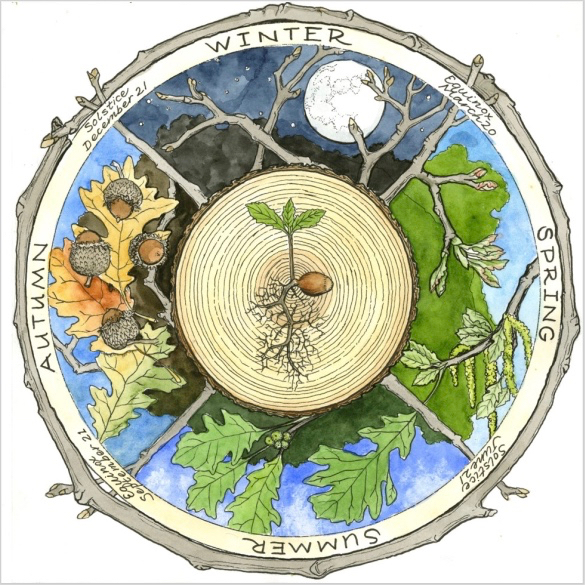Homesteaders - Phenology: Planting According to Nature
For homesteaders and gardeners, spring wins the crown of the season of overwhelm.
Budding weeds are peeled back from the gardens. The chickens will rush out to the grasses looking for chickweed, clover, and bugs so we clean the coop completely and move the compost out of their pens. Seeds have been started in the greenhouse, starts have been purchased, or dates have been put on the calendar for direct sowing. Some things have to be planted before last frost, others after. If you're new to homesteading, it's a struggle to keep up. For every task planned, a handful more are found needing to be done. A two-hour job becomes half a day's work. And there's still more to do.
It's the folks who have been here before, year after year, who seems to take this season in better stride. They have the same work, but they seem to be able to plan for it more easily.
I always forage wood avens root on March 25th. A neighbor always plants potatoes on St. Patrick's Day. Always.
It occurred to me there must be more traditional dates. What map can a newbie homesteader use to plan gardens and raising animals? I had heard of planting by the moon and planting by the astrological signs, and then I heard of phenology - planting according to nature. Phenology looks to new animal and insect life, plant budding, leafing, flowering, bird migration and nesting, and more as signs for when to plant what kind of crops. Watching for these signs means we can stop relying on certain types of weather and temperatures to happen by certain dates.
Changing weather patterns are normal. Climate change cycles are verified through the reading of ice core samples from Antarctica (800,000 years back) and Greenland (130,000 years back). The cycles show either global warming or cooling, to greater or lesser degrees. The National Science Foundation (NSF), a part of the U.S. Geological Survey, runs the ice-core facility where scientists study and record the data from the samples and determine whether or not the planet is in a cooling or warming phase in this time of its long history, with sometimes Antarctica warming while Greenland was cooling and vice versa.
According to these scientists, none of the greenhouse gasses we have been polluting the earth with have been responsible for climate cooling or warming. We have, however, polluted our air, water, and soil so much that it is causing animal and insect extinctions and we're not doing ourselves any great favors.
The closest we have come to "changing climate" comes in the form of cloud seeding and more recently laying down of chemtrails, a newer method of seeding the atmosphere to produce rain over targeted agricultural areas. By adding silver iodide among other things to the atmosphere, the likelihood of rain increases. This makes it harder to predict what "normal" weather because it can be adjusted by even a 20% greater chance of precipitation. Artificially "pushed" precipitation changes wind patterns, not globally, necessarily, but temporarily over a thousand miles.
So if we can't count on normal seasonal weather, what can we count on? If the season's weather can be so variable that the season, itself, seems to have moved forwards or backwards by several weeks, traditional dates may fail us.
Enter phenology. Phenology is a science focused on observing and recording biological events from year to year and their relationships to the change of seasons and climate.
We might remember, from year to year, that we've planted beets, carrots, and cabbages when the daffodils have bloomed. Or maybe we planted potatoes the dandelions covered the lawn. What we may not know is that these are the nature's signs of soil and seasonal temperature and readiness for these crops regardless of the calendar date. Phenology observes these signs and makes a record of them. Farmers and gardeners match those signs to what grows well at the same time, what needs the same conditions to thrive. This is planting according to nature.
Aldo Leopold is considered by many to be the father of wildlife ecology.
There are lists of what to plant when, but the when is when something is budding, blooming, migrating, or hibernating rather than a specific date can be circled on a calendar.
Some phenology phrases passed down include:
- Wasps building nests in exposed places indicate a dry season.
- When the daffodils begin to bloom it is time to plant peas, beets, carrots, and cabbage.
- Plant corn when oak leaves are the size of a squirrels’ ear.
- When the blossoms of the apple tree begin to fall, plant your corn seeds, pole beans, cucumber, basil, and marigold.
- When the lilac plant has leafed out plant lettuce, peas and other cool weather varieties. When its’ flowers have faded plant cucumbers and squash.
- When the flowering dogwood is in peak bloom it is time to plant tomatoes, early corn and peppers .
- Plant tomatoes and peppers when daylilies start to bloom.
- When dandelions are blooming plant beets and carrots.
Some of these phrases may contradict each other. For that reason, it's important to note whether the phrases come from your zone or even your country. Ireland has its own phenology observations and they will be different from Kansas or North Carolina in the U.S.
What signs do you plant by?


Comments
Post a Comment